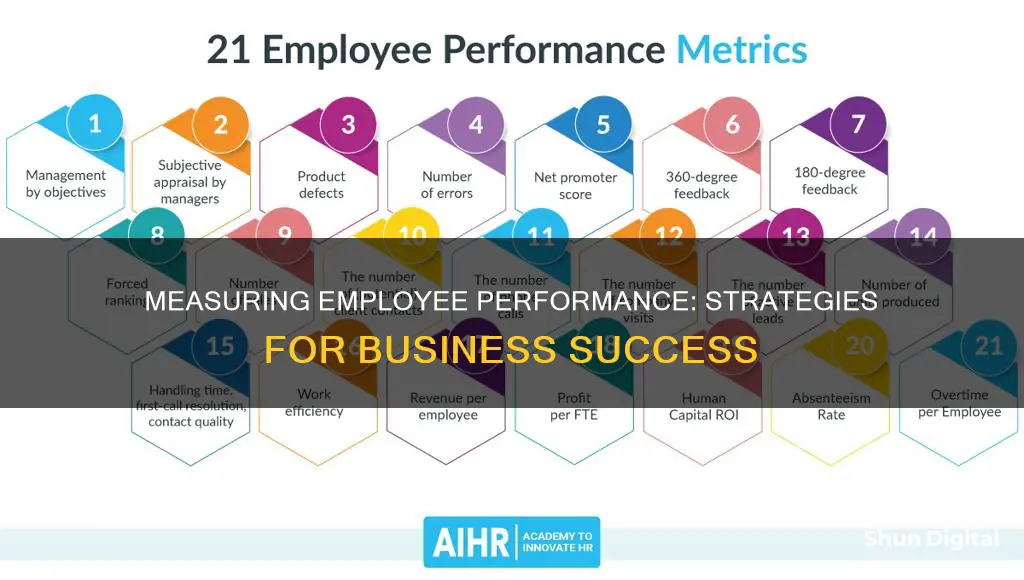
Monitoring and measuring employee performance is an important aspect of staying competitive and driving business success. It helps businesses evaluate how employees are handling their responsibilities and progressing over time. While businesses can use performance management software to streamline the monitoring process, there are also other effective strategies to gain insights into employee performance. These include regular check-ins and one-on-one meetings, 360-degree feedback, self-reported surveys, and direct observation. By implementing these strategies, businesses can improve employee satisfaction, productivity, and overall performance, which positively impacts the success of the organisation.
What You'll Learn

Regular check-ins and one-on-one meetings
Scheduling and Frequency
It is important to schedule regular meetings at consistent intervals. These can be weekly, bi-weekly, or monthly check-ins, depending on the needs of the team and the individual employees. For example, BambooHR, a performance evaluation tool, allows for up to four formal reviews per year, in addition to project-specific assessments and impromptu check-ins. Regularity is key to building trust and ensuring that both parties are on the same page.
Agenda and Topics
Managers should come prepared with an agenda to ensure that the meetings are productive and focused. Here are some suggested topics to cover during these check-ins:
- Progress towards goals and objectives: Review the employee's progress on their goals and discuss any challenges or roadblocks they are facing.
- Performance feedback: Provide constructive feedback on the employee's recent performance, highlighting areas of improvement and strengths.
- Concerns and issues: Create a safe space for employees to voice any concerns, issues, or frustrations they may have.
- Guidance and support: Offer guidance and support to help employees overcome challenges and improve their performance.
- Future goals and action steps: Work together to set achievable goals for the upcoming period and determine the action steps required to achieve them.
Creating a Safe and Supportive Environment
It is crucial to establish a safe and non-judgmental environment during these check-ins. Encourage open and honest communication by actively listening to your employees' concerns and providing reassurance. Ensure that the meetings are two-way conversations where both parties have the opportunity to speak and be heard.
Documentation and Follow-up
Take detailed notes during the meetings to document important discussions, decisions made, and action items. After the meeting, follow up with a summary email outlining the key points, next steps, and any tasks that need to be completed. This ensures that everyone is on the same page and provides a reference point for future meetings.
Benefits of Regular Check-ins and One-on-One Meetings
- Performance improvement: These meetings provide an opportunity to identify areas where employees may be struggling and offer guidance to help them improve.
- Transparent feedback loop: They create a transparent feedback loop, allowing managers to provide constructive feedback and employees to voice their concerns.
- Relationship building: They foster a positive working relationship between managers and employees, built on trust and open communication.
- Issue resolution: Regular check-ins allow for the early identification and resolution of issues, ensuring that small problems don't escalate.
- Alignment with company goals: These meetings help employees understand how their contributions align with the company's goals, increasing their engagement and motivation.
In conclusion, regular check-ins and one-on-one meetings are a vital tool for monitoring and measuring employee performance. They provide a forum for open communication, performance evaluation, and guidance, ultimately contributing to the success of both the individual and the organization as a whole.
Wifi Adapter Monitor Mode: How to Check?
You may want to see also

Performance management software
BambooHR
BambooHR is a performance appraisal software that assists HR departments in creating accurate reviews based on employee responses. It allows managers to plan assessments, review employee work, and track employee progress with evaluation grids on a single page. BambooHR also enables feedback collection and highlights employee career developments. Additionally, it provides company progress reports to measure achievements and set future objectives.
PerformYard
PerformYard simplifies HR processes by facilitating formal evaluations and reporting. It allows organizations to set up the system according to their specific needs. PerformYard is a feedback and performance-focused system that collects reviews and regular check-ins from employees. It helps employees manage their daily, weekly, and monthly goals while providing employers with tracking capabilities and feedback options. The software also generates reports to monitor progress before the end-of-year evaluations, ensuring desired results.
Trakstar
Trakstar is a trusted platform used by HR professionals and managers to evaluate employees. It keeps employees engaged and enables them to complete timely review cycles. The software assists employees in creating value for the organization by staying on top of their goals and provides extensive results to encourage better performance. Trakstar allows employers to create job description segments and set team expectations, reducing the effort required by HR. Regular reviews and feedback from both employees and employers promote a positive work environment.
ChartHop
ChartHop is a platform that helps derive meaning from performance review cycles to facilitate employee growth. It allows organizations to personalize and tailor performance review questions to their specific needs. The tool reflects on employee performances and growth, enabling the setting of goals and evaluation of performance levels.
Eloomi
Eloomi is a performance appraisal system that assists with employee onboarding, evaluation, and training. It provides employees with video tutorials for specific skills, compliance surveys, daily checklists, and survey tools. Eloomi enables employees to measure their progress with tasks and skills and facilitates communication with managers regarding feedback and scores. The interface guides users to relevant skills and encourages individuals to work on self-improvement.
AssessTeam
AssessTeam is a 360-degree performance evaluation software that is easily installed and accessible via mobile devices. It provides simple evaluation tools to track employee skills and consistency in alignment with organizational values. AssessTeam offers flexibility to HR departments, allowing them to alter processes and provide feedback based on employee engagement with company values. The software enables employees to access feedback from various sources, including managers from different departments. It also includes a 30-60-90 evaluation method to track employee progress at regular intervals and compare it with industry performance standards.
Culture Amp
Culture Amp is a performance management software that aligns employees with company values and principles. It helps employees recognize their goals and expectations, fostering a culture of feedback and progress. The platform offers consistent tracking of employee motivation and development, empowering teams and enhancing performance. Culture Amp establishes a connection between managers and employees to encourage team spirit and provides employers with tools to evaluate employee-set goals.
Lattice
Lattice is a platform designed to encourage and motivate employees across departments. It assists management in supporting their employees' progress within the company. Lattice provides regular updates and goal-setting features, helping teams set agendas and align meetings. The software encourages managers to conduct one-on-one sessions with employees for reviews. Visible praise and feedback features keep teams motivated and prepared to take on subsequent tasks. Lattice enables employees to track individual and team performances, contributing to their growth.
These software solutions showcase the diverse range of performance management tools available to businesses. Each platform offers unique features to streamline performance monitoring, evaluation, and feedback processes, ultimately driving employee engagement and improving overall business performance.
Mortgage Monitoring: Key Factors to Consider Before Buying
You may want to see also

Self-reported surveys
However, there are limitations to self-reported surveys. For instance, employees may censor themselves or provide responses that are more compliant with company politics out of fear of losing their jobs. Additionally, without objective data, employees may not have sufficient discussion points or a basis for their responses. Therefore, it is crucial that surveys are professionally scripted and carefully worded to ensure employers receive meaningful feedback while providing employees with a platform to communicate truthfully.
One example of a self-reported survey is the Individual Work Performance Questionnaire (IWPQ), which measures the three main dimensions of job performance: task performance, contextual performance, and counterproductive behaviours. The IWPQ has been adapted for use in different languages and cultures, demonstrating its versatility and applicability in various contexts.
Another benefit of self-reported surveys is that they can be easily distributed and completed through digital platforms or tools, making them accessible and convenient for employees to provide feedback. This method of performance evaluation can be particularly useful when combined with other evaluation methods, such as peer reviews, to gain a holistic understanding of employee performance.
Monitoring Bandwidth Usage on Your iPad: A Step-by-Step Guide
You may want to see also

360-degree feedback
Structure and Content
The feedback should focus on the employee's strengths and areas for improvement, covering various competencies such as communication skills, problem-solving skills, leadership skills, adaptability, and time management.
Examples of 360-Degree Feedback Questions:
- How effectively does the individual listen and understand others' viewpoints?
- Does the employee possess leadership qualities and motivate others in the team?
- Can the employee adapt to changes in work demands and unexpected situations?
- How well does the employee evaluate risks and make informed decisions?
- How effectively does the individual prioritise tasks and meet deadlines?
Implementation and Process
Sample Feedback Statements:
Positive Feedback:
- "You excel at facilitating open communication within the team, creating an environment where everyone feels comfortable sharing their ideas."
- "Your active listening skills are impressive. During team meetings, you always acknowledge everyone's input, making us feel valued and heard."
- "Your leadership skills are impressive. You consistently motivate and guide the team, ensuring everyone is aligned and working towards our goals."
Constructive Feedback:
- "Sometimes, it feels like you do not fully address team concerns in meetings. It might be helpful to dedicate a few minutes to open discussion to ensure everyone's voice is heard."
- "I recognise that I need to work on my active listening skills. Sometimes, I catch myself multitasking during conversations, which can lead to misunderstandings."
- "There are times when your leadership style could be more inclusive. Some team members feel their ideas are not always considered."
Benefits of 360-Degree Feedback:
Additionally, 360-degree feedback can increase employee engagement, improve productivity, and reduce turnover by creating a culture of open and constructive communication.
Potential Challenges:
One common challenge with 360-degree feedback is ensuring honest and open responses from participants. To address this, anonymity and encouragement from management can be emphasised. Additionally, providing examples of how honest feedback has benefited previous recipients can create a more positive perception of the process.
Comparison with Other Methods:
Best Practices:
When implementing 360-degree feedback, it is important to ensure that questions are structured fairly, focus on specific areas, use straightforward language, and are relevant to the organisation and the individual being reviewed.
Additionally, providing a clear framework or guidelines for giving feedback, such as the "Start, Stop, Continue" approach, can help participants structure their responses constructively.
Overall, 360-degree feedback is a valuable tool for employee development and performance evaluation, offering a comprehensive understanding of strengths and areas for improvement, and fostering a culture of continuous improvement within an organisation.
Choosing the Right-Sized Drawing Monitor for Your Needs
You may want to see also

Visual monitoring
Managers can make it a habit to move around the workplace throughout the day to gauge employees' attitudes and quickly spot any problems. For example, if an employee seems abnormally frustrated, they may need guidance or assistance. However, it is also important to shadow employees for more extended periods to identify any inefficient habits or weak skills.
While visual monitoring can provide valuable insights, it may not always be feasible, especially for remote or distributed teams. In such cases, other methods, such as regular check-ins, performance management software, and employee monitoring software, can be utilised to track and evaluate employee performance.
Removing Arcade Monitors: A Step-by-Step Guide
You may want to see also
Frequently asked questions
Monitoring employee performance helps businesses to identify areas of improvement and ensure that employees are fulfilling their responsibilities and contributing to the company's success. It also aids in future growth planning and helps employees reach their full potential, improving overall performance and morale.
Businesses can utilise various methods, such as regular check-ins and one-on-one meetings, performance management software, employee monitoring software, peer reviews, self-reported surveys, and direct observation.
Key metrics include the standard of work produced, speed and efficiency in task completion, trust and consistency in delivering high-quality work, and the employee's contribution to the company's goals and overall success.
Businesses can improve employee performance by setting clear and measurable goals, providing regular feedback, creating a positive workplace culture, prioritising learning and development, and recognising and rewarding great work.







